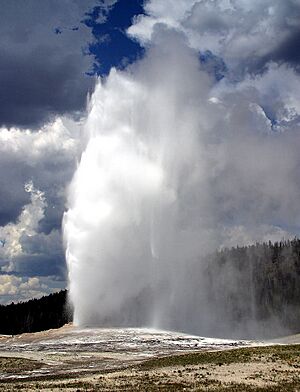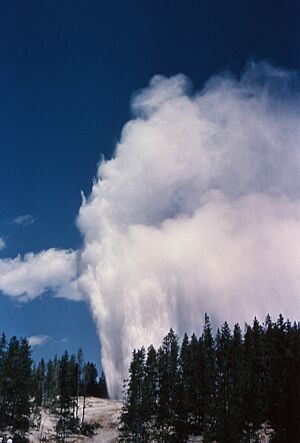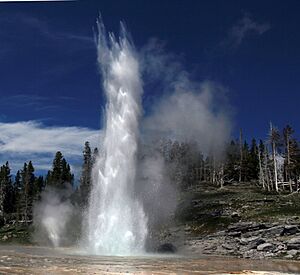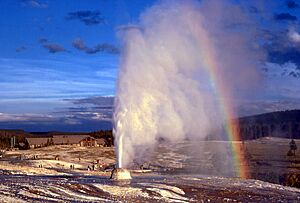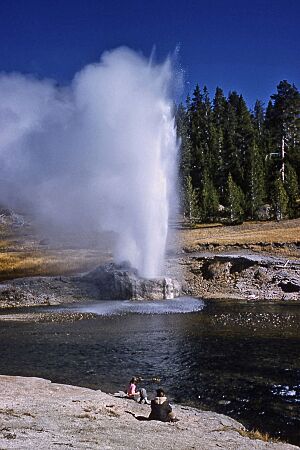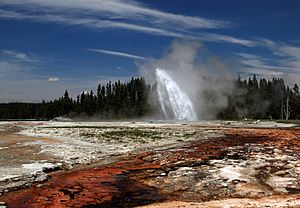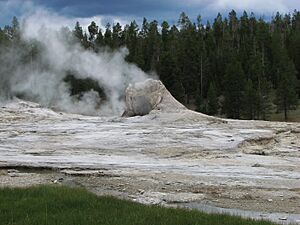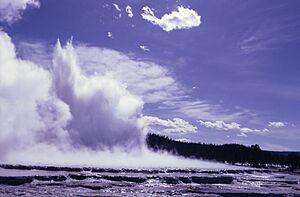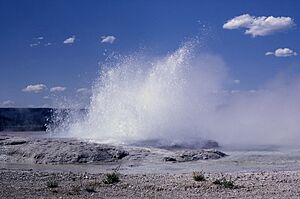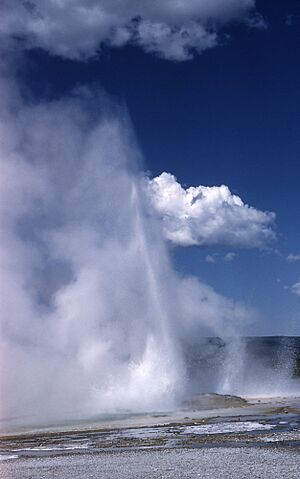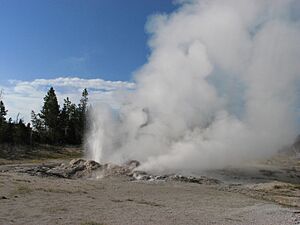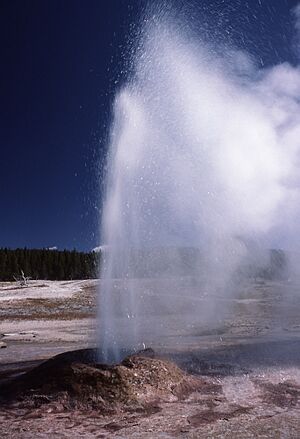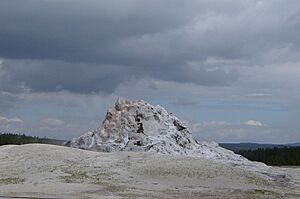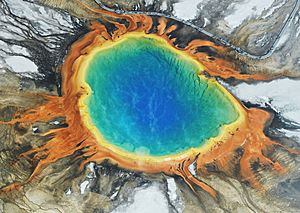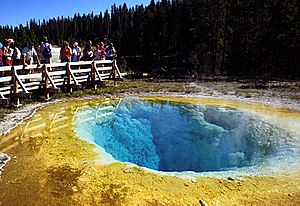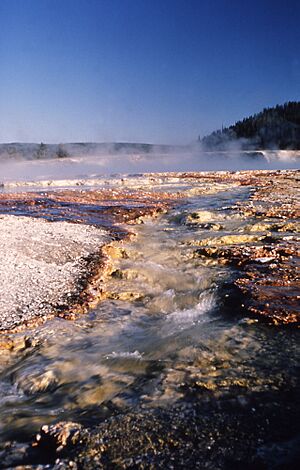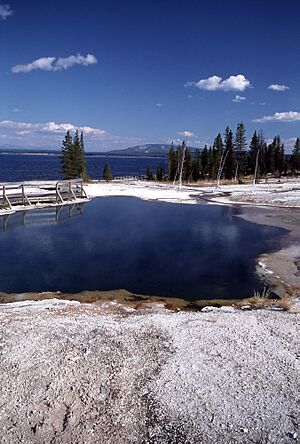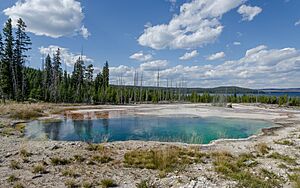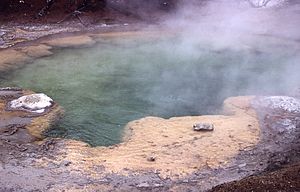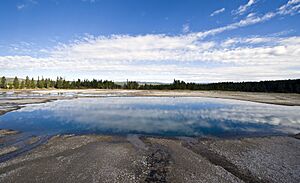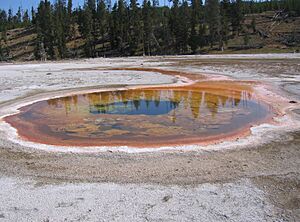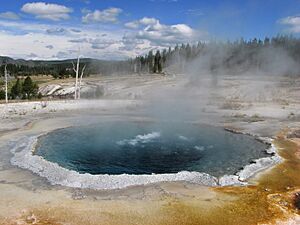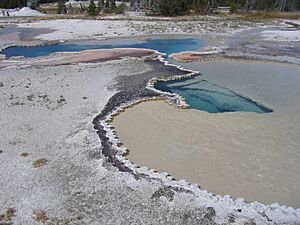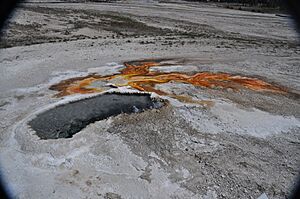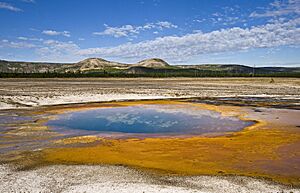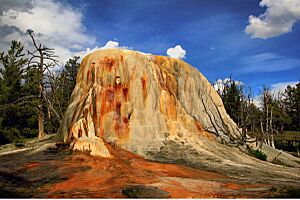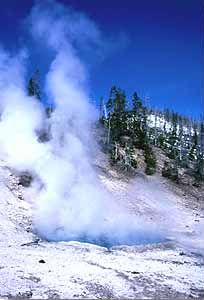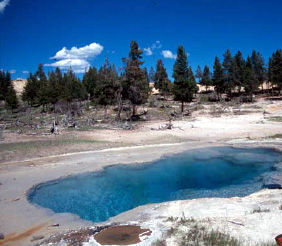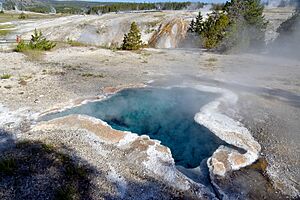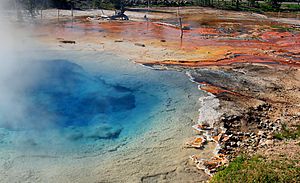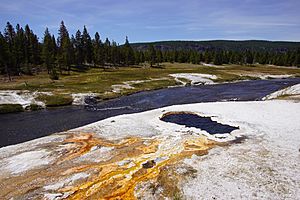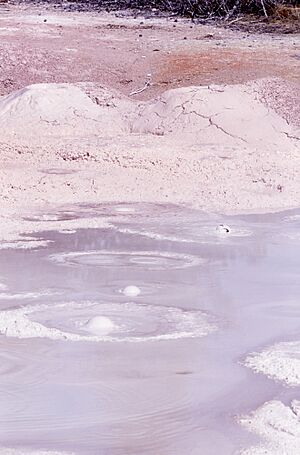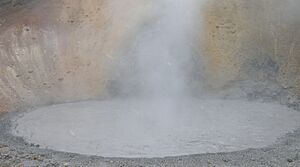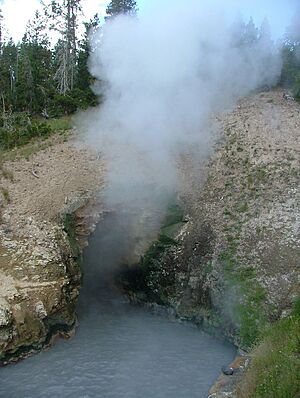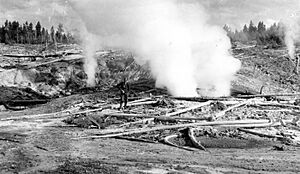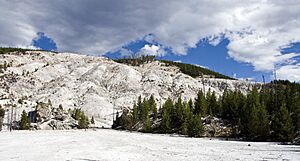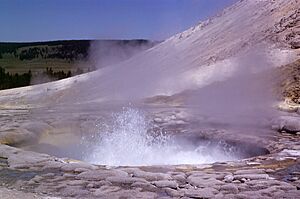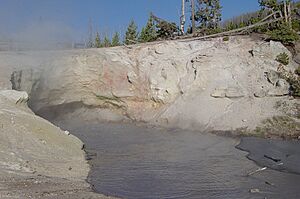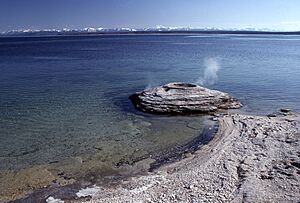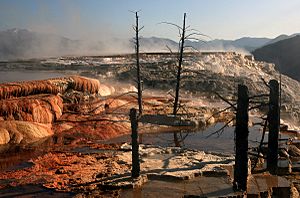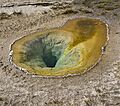List of Yellowstone geothermal features facts for kids
Yellowstone National Park is a super cool place, famous for its amazing natural wonders! Imagine bubbling mud, steaming vents, and powerful water eruptions shooting high into the sky. These are all part of Yellowstone's incredible geothermal features.
Yellowstone sits on top of a giant "hot spot" in the Earth. This means there's a lot of heat from deep underground that warms up water. When this hot water finds its way to the surface, it creates all sorts of unique features like geysers, hot springs, and mud pots. It's like the Earth is showing off its power!
Contents
What Are Geysers, Hot Springs, and Mud Pots?
Yellowstone is home to thousands of these geothermal features. Each one is special and behaves differently.
Geysers
Geysers are like natural water fountains that erupt! Water heats up deep underground in cracks and channels. When it gets hot enough, it turns into steam, which builds up pressure. Eventually, this pressure pushes the water and steam out of the ground in a powerful burst.
- Old Faithful Geyser is probably the most famous geyser in the world! It erupts very regularly, usually every 60 to 90 minutes. Its eruptions can shoot water over 100 feet high! It's a must-see for anyone visiting Yellowstone.
- Steamboat Geyser is the tallest active geyser on Earth. When it erupts fully, it can shoot water more than 300 feet (about 90 meters) into the sky! These huge eruptions don't happen often, but when they do, it's an amazing sight.
- Grand Geyser is another impressive geyser. It erupts in a series of bursts, sometimes reaching over 200 feet high. It's often joined by its smaller friends, Turban Geyser and Vent Geyser, which erupt at the same time.
- Beehive Geyser is known for its tall, narrow column of water, which looks like a beehive. It doesn't erupt as often as Old Faithful, but its eruptions are very powerful, sometimes reaching over 200 feet.
- Castle Geyser has a unique cone shape that looks like a castle ruin. It has long, powerful eruptions that can last for 20 minutes or more, followed by a loud steam phase.
- Riverside Geyser is special because it erupts into the Firehole River. When it goes off, it creates a beautiful arc of water over the river. It erupts about every 5 to 7 hours.
- Daisy Geyser is a very reliable geyser, erupting every few hours. Its eruptions are usually angled, shooting water about 75 feet high.
- Giant Geyser is one of the largest geysers in Yellowstone. Its eruptions are rare but spectacular, reaching heights of over 250 feet.
- Great Fountain Geyser is known for its beautiful, wide eruptions that look like a giant fountain. It erupts every 9 to 15 hours, and its bursts can reach 100 to 200 feet high.
- Fountain Geyser is another active geyser in the Lower Geyser Basin. It has frequent, powerful eruptions that can reach 50 feet high.
- Clepsydra Geyser is a very active geyser that often erupts continuously for long periods. It's located near the Fountain Geyser.
- Jet Geyser is a smaller but active geyser, often erupting with Fountain Geyser.
- Pink Cone Geyser is a small geyser with a pinkish cone, known for its frequent, short eruptions.
- White Dome Geyser has a large, white cone built up over many years. It erupts frequently, sending water and steam high into the air.
Hot Springs and Pools
Hot springs are pools of hot water that rise from underground. They don't erupt like geysers, but their colors can be absolutely stunning! The colors come from tiny living things called thermophiles, which love hot water.
- Grand Prismatic Spring is the largest hot spring in the United States and one of the most beautiful. It's famous for its bright, rainbow-like colors, from deep blue in the center to green, yellow, and orange rings around the edges. It's like a giant, colorful eye on the Earth!
- Morning Glory Pool is a hot spring known for its beautiful blue color. Over time, people throwing coins and trash into the pool have blocked its vents, causing it to cool and change color to green and yellow around the edges. It's a reminder to protect these natural wonders!
- Excelsior Geyser is now a huge, steaming hot spring. It used to be a giant geyser that erupted powerfully in the late 1800s, but now it's a massive, beautiful pool that flows into the Firehole River.
- Black Pool in the West Thumb Geyser Basin was once a deep, dark blue pool. But it has heated up over time, killing the thermophiles that gave it its dark color, and now it's often a bright, clear blue.
- Abyss Pool is one of the deepest hot springs in Yellowstone. It's a beautiful, deep blue color and can sometimes overflow.
- Emerald Spring is a small but vibrant hot spring in Norris Geyser Basin. Its name comes from its beautiful emerald green color, caused by algae living in its warm waters.
- Turquoise Pool is another stunning hot spring known for its clear, bright turquoise blue water. It's a beautiful sight to behold.
- Chromatic Spring is a large, colorful hot spring located near Grand Prismatic Spring. Its vibrant colors come from different types of bacteria and algae that thrive in its varying temperatures.
- Crested Pool is a very hot and deep hot spring. It's usually a calm, clear blue, but it can sometimes erupt like a geyser.
- Doublet Pool is known for its beautiful, clear water and the delicate, scalloped edges of its basin. You can often see gas bubbles rising from its depths.
- Ear Spring is a hot spring named for its shape, which looks a bit like an ear. It's known for its bright orange and yellow colors around the edges.
- Opal Pool is a hot spring that changes its water level and temperature. It can sometimes overflow or even erupt as a geyser.
- Orange Mound Spring is a unique feature at Mammoth Hot Springs. It's a small, orange-colored mound formed by minerals deposited by the hot water.
- Beryl Spring is a very hot and active hot spring in the Gibbon Geyser Basin. Its bright blue water is very clear.
- Azure Spring is a beautiful blue spring in the Lower Geyser Basin. Its name means "sky blue," which perfectly describes its color.
- Blue Star Spring is a small, star-shaped hot spring with clear blue water. It's a lovely, peaceful spot.
- Silex Spring is a large, clear hot spring in the Fountain Paint Pots area. Its name comes from the silica minerals that line its basin.
- South Scalloped Spring is a hot spring with unique scalloped edges, formed by mineral deposits.
Mud Pots and Steam Vents
Not all geothermal features are about clear water!
- Fountain Paint Pots are a collection of colorful mud pots. These are hot springs where the water mixes with clay and minerals, creating thick, bubbling mud. The colors come from different minerals in the mud. It's like a giant, natural art palette!
- Mud Volcano is a large, bubbling mud pot that looks like a mini volcano. It's known for its loud burping and gurgling sounds as gases escape from the mud.
- Dragon's Mouth Spring is a cave-like hot spring that constantly steams and hisses, making sounds like a dragon breathing! It's a very active and loud feature.
- Black Growler Steam Vent is a powerful steam vent that releases hot steam and gases with a loud roaring sound. It's a reminder of the intense heat beneath Yellowstone.
- Roaring Mountain is an area with many steam vents that make a loud roaring sound, especially when the weather is cold. It's like the mountain itself is breathing!
- Sulphur Spring is a hot spring with a strong smell of sulfur, like rotten eggs. This smell comes from gases released from underground.
- Green Dragon Spring is a hot spring in Norris Geyser Basin with a greenish color and a strong sulfur smell, giving it a "dragon-like" feel.
Other Interesting Features
Yellowstone has even more unique geothermal spots!
- Fishing Cone is a small, cone-shaped hot spring right on the edge of Yellowstone Lake. In the past, people used to catch fish in the lake and then cook them right in the hot spring! This is no longer allowed to protect the park.
- Mammoth Hot Springs is a unique area where hot water flows over terraces, depositing minerals that create beautiful, colorful formations. It looks like a landscape from another planet! The hot water constantly changes the shape and color of these terraces.
Yellowstone's geothermal features are a truly amazing part of our planet. They show us the powerful forces at work deep beneath the Earth's surface. Remember to always stay on the boardwalks and trails to keep yourself safe and protect these fragile natural wonders!
Images for kids


